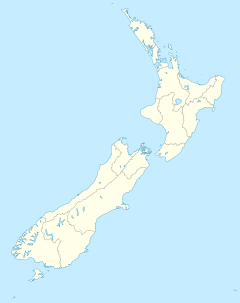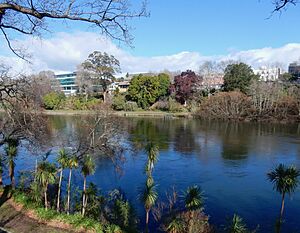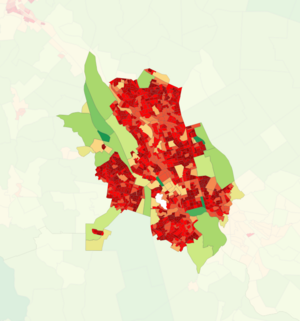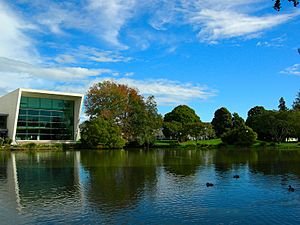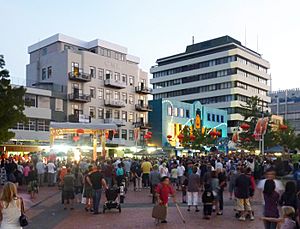Hamilton, New Zealand facts for kids
Quick facts for kids
Hamilton
Kirikiriroa (Māori)
|
||
|---|---|---|

Hamilton from Till's Lookout, from Whitiora to Fairfield Bridge, traffic on SH1, Māori Garden, Hamilton Station, city offices and WINTEC
|
||
|
||
| Nicknames:
Hamiltron, the Tron, H-Town. Previously: the Fountain City.
|
||
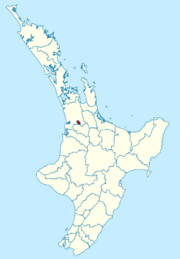
Location of the Hamilton Territorial Authority
|
||
| Country | New Zealand | |
| Island | North Island | |
| Region | Waikato | |
| Wards | West East Kirikiriroa (Māori) |
|
| Area | ||
| • Territorial | 110.8 km2 (42.8 sq mi) | |
| • Urban | 110.37 km2 (42.61 sq mi) | |
| Elevation | 40 m (131 ft) | |
| Population
(June 2023)
|
||
| • Territorial | 185,300 | |
| • Density | 1,672.4/km2 (4,331.5/sq mi) | |
| • Urban | 185,300 | |
| • Urban density | 1,678.9/km2 (4,348.3/sq mi) | |
| • Demonym | Hamiltonian | |
| Time zone | UTC+12 (NZST) | |
| • Summer (DST) | UTC+13 (NZDT) | |
| Postcode(s) |
3200, 3204, 3206, 3210, 3214, 3216
|
|
| Area code(s) | 07 | |
| Local iwi | Tainui | |
| Website | www.hamilton.govt.nz www.waikatoregion.govt.nz |
|
Hamilton (Māori: Kirikiriroa) is a large city in the North Island of New Zealand. It's located on the banks of the Waikato River, which is the longest river in New Zealand. Hamilton is the main city of the Waikato region.
With a population of over 174,000 people, it is the fourth most-populous city in New Zealand. Hamilton covers an area of about 110 square kilometers. In 2020, Hamilton was named the most beautiful large city in New Zealand. It is also one of the fastest-growing cities in the country.
The area where Hamilton now stands was once home to several Māori villages. One of these villages was called Kirikiriroa, which is where the city gets its Māori name. Many of these villages were left empty after the Invasion of Waikato and the land confiscation by the Crown.
Later, settlers developed Hamilton as a center for farming services. Today, it has a diverse economy with many different industries. Hamilton Gardens is a very popular place to visit. Education and research are also very important to Hamilton's economy. The city has about 40,000 university students and many scientists.
Contents
- Naming the City of Hamilton
- Hamilton's History
- Hamilton's Geography
- Hamilton's Population
- Hamilton's Economy
- Culture and Arts in Hamilton
- Media in Hamilton
- Places to Visit in Hamilton
- Hospitals in Hamilton
- Getting Around Hamilton
- Education in Hamilton
- City Services
- Notable People from Hamilton
- Sister Cities
- See also
Naming the City of Hamilton
Hamilton was named by Colonel William Moule. He named it after Captain John Fane Charles Hamilton. Captain Hamilton was a commander who died in a battle in Tauranga.
In 2013, a statue of Captain Hamilton was given to the city. However, some people found this controversial. In 2020, the Hamilton City Council removed the statue. This happened after local Māori groups, especially Waikato Tainui, asked for it to be taken down.
The removal of the statue was part of a bigger movement. People around the world were asking for statues of figures linked to colonialism to be removed. A local Māori elder, Taitimu Maipi, has also suggested renaming the city Kirikiriroa. This was its original Māori name.
Hamilton's History
Early Māori Settlements
Before Europeans arrived, the Hamilton area had several Māori villages. These included Te Parapara, Pukete, Miropiko, and Kirikiriroa. Kirikiriroa means "long stretch of gravel" and is the city's Māori name.
During the Musket Wars, Māori in this area were sometimes attacked by the Ngāpuhi tribe. You can still find old pā (fortified villages) sites along the Waikato River from this time. In 2011, old food storage pits were found near the Waikato River.
In the 1830s, Kirikiriroa was the main village for the Ngāti Wairere tribe. Missionaries who visited estimated about 200 people lived there. A chapel was built for visiting church leaders.
Between 1845 and 1855, Māori farmers grew crops like wheat, fruit, and potatoes. They sent these to Auckland using up to 50 canoes from Kirikiriroa. They also traded for blankets, clothes, and tools.
Before the Invasion of Waikato in 1863–64, Kirikiriroa had about 78 people. After the war, large areas of land, including Hamilton, were taken by the Crown. Most Māori villages were then abandoned.
European Settlement and Growth
After the land was taken, soldiers and settlers were brought in from Australia. The first military settlers arrived in Hamilton on August 24, 1864. They came on a paddle steamer called the Rangiriri.
Many of these soldier-settlers found the land difficult to farm. It was often swampy or underwater. By 1868, Hamilton's population dropped from 1,000 to 300 as many farmers left.
The road from Auckland reached Hamilton in 1867. The railway arrived in December 1877. Soon after, the towns of Hamilton West and Hamilton East joined together. The first bridge connecting them opened in 1879. It was replaced by the Victoria Bridge in 1910.
The first railway bridge, the Claudelands Bridge, opened in 1884. It was later changed into a road bridge in 1965. Hamilton's population reached 1,000 by 1900. The town of Frankton joined Hamilton in 1917. Hamilton officially became a city in 1945.
In the late 1800s, areas like Te Rapa and Pukete were important for collecting kauri gum. This was a valuable resin from kauri trees.
Modern Hamilton
Hamilton has continued to grow quickly. New developments are happening, especially in the northern parts of the city. Traffic has increased because of this growth.
State Highway 1 runs through Hamilton's western and southern areas. The Waikato Expressway was built to help ease traffic. It takes State Highway 1 around the city.
The rapid growth has also led to urban sprawl. This means the city is spreading out into surrounding areas. More development is planned for suburbs like Rototuna and Peacocke.
Hamilton's Geography
Hamilton's landscape was shaped by volcanic ash and floods. These events happened thousands of years ago. The Waikato River also changed its path over time.
Most of Hamilton's land is quite flat. However, there are many low hills. There is also a large network of gullies (small valleys). The soil is soft and can be easily eroded by rain.
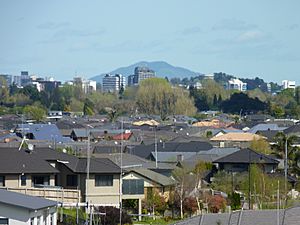
Hamilton Central, from Somerset Heights.
|
In the past, Hamilton was very swampy, especially in winter. It had many small lakes and peatlands. Most of these swamps have now been drained. Early photos show how muddy the roads could be.
Lake Rotoroa (Hamilton Lake) started forming about 20,000 years ago. It was once part of an old river system. The lake is a popular spot for fun activities. You can enjoy walking trails, picnic areas, and water sports. The paths around the lake are great for jogging, walking, and cycling.
Hamilton's Suburbs
Hamilton has many suburbs, divided into western and eastern areas.
Western Hamilton Suburbs
- Beerescourt
- Bader
- Crawshaw
- Deanwell
- Dinsdale
- Fitzroy
- Forest Lake
- Frankton
- Glenview
- Grandview Heights
- Hamilton Central
- Hamilton North
- Hamilton West
- Livingstone
- Maeroa
- Melville
- Nawton
- Peacocke
- Pukete
- Rotokauri
- St Andrews
- Stonebridge
- Te Rapa
- Temple View
- Thornton
- Western Heights
- Whitiora
Eastern Hamilton Suburbs
- Ashmore
- Callum Brae
- Chartwell
- Chedworth Park
- Claudelands
- Enderley
- Fairfield
- Fairview Downs
- Flagstaff
- Hamilton East
- Harrowfield
- Hillcrest
- Huntington
- Magellan Rise
- Queenwood
- Ruakura
- Riverlea
- Rototuna
- Silverdale
- Somerset Heights
- St James Park
- St Petersburg
Towns and Suburbs in the Hamilton Urban Area
- Cambridge
- Te Awamutu
- Ngāruawāhia
- Taupiri
- Horotiu
- Horsham Downs
- Huntly
- Gordonton
- Ōhaupō
- Ngāhinapōuri
- Te Kowhai
- Whatawhata
- Tamahere
- Matangi
- Tauwhare
- Rukuhia
- Kihikihi
Hamilton's Climate
Hamilton has an oceanic climate. This means its temperatures are not too extreme because New Zealand is surrounded by the ocean.
In winter, Hamilton can be cool. Mornings can be very cold, sometimes dropping below freezing. In summer, it can be one of the warmest places in the country. Temperatures often go above 25°C. Hamilton also has high humidity, which can make it feel hotter or colder.
Ground frosts are common in winter. Snow is very rare, but light snowflakes were seen in August 2011.
Hamilton gets a lot of rain, about 1,100 mm per year. This rain, along with plenty of sunshine, makes the Waikato region very fertile for farming. Summers are usually dry, and winters are wet.
Fog is common on winter mornings, especially near the Waikato River. However, the fog usually clears by noon, leading to sunny days. Hamilton is also one of the least windy cities in New Zealand. This is because it is inland and surrounded by hills.
Hamilton's Population
| Historical population | |||||||||||||||||||||||||||||||||||||||||||||||||||||||
|---|---|---|---|---|---|---|---|---|---|---|---|---|---|---|---|---|---|---|---|---|---|---|---|---|---|---|---|---|---|---|---|---|---|---|---|---|---|---|---|---|---|---|---|---|---|---|---|---|---|---|---|---|---|---|---|
|
|
||||||||||||||||||||||||||||||||||||||||||||||||||||||
| New Zealand census | |||||||||||||||||||||||||||||||||||||||||||||||||||||||
In the 2023 New Zealand census, Hamilton had a population of 174,741 people. This was an increase of 13,830 people since 2018. The city has grown by over 33,000 people since 2013.
The median age in Hamilton was 33.2 years, which is younger than the national average. About 20.9% of the population was under 15 years old. Another 23.4% were aged 15 to 29.
Hamilton has a large number of university students. This means many people live in the city for a few years while studying. Hamilton is the second fastest-growing city in New Zealand, after Auckland.
| Name | Area (km2) |
Population | Density (per km2) |
Dwellings | Median age | Median income |
|---|---|---|---|---|---|---|
| West General Ward | 64.18 | 80,817 | 1,259 | 29,235 | 33.1 years | $43,600 |
| East General Ward | 46.19 | 93,921 | 2,033.4 | 31,662 | 33.2 years | $40,900 |
| New Zealand | 38.1 years | $41,500 |
Culture and Identity
Hamilton is a diverse city. People can identify with more than one ethnic group.
- 58.5% identified as European (Pākehā).
- 25.4% identified as Māori.
- 6.8% identified as Pasifika.
- 22.8% identified as Asian.
- 2.7% identified as Middle Eastern, Latin American, and African (MELAA).
- 2.0% identified with other groups.
English is spoken by most people (94.0%). The Māori language is spoken by 6.8%. Other languages are spoken by 20.6% of the population. About 30.1% of people in Hamilton were born overseas.
Many people in Hamilton have a religious belief. 32.4% are Christian, 4.4% are Hindu, and 2.7% are Muslim. About 47.8% of people said they had no religion.
Hamilton's Economy
Education and research are very important to Hamilton's economy. The city has two main universities: the University of Waikato and the Waikato Institute of Technology (Wintec). Research centers like Ruakura have helped New Zealand's farming industry grow.
Hamilton's main source of income comes from the dairy industry. This is because it is in the middle of New Zealand's largest dairy farming area.
Every year, Hamilton hosts the National Agricultural Fieldays at Mystery Creek. This is the biggest farming trade show in the Southern Hemisphere. Mystery Creek is a large event center. It also hosts other big events like the National Car Show.
Manufacturing and retail are also important. Hamilton has New Zealand's largest aircraft manufacturer, Pacific Aerospace. They have made over 1,000 aircraft. The city is also home to Gallagher Group Ltd, which makes electric fences and security systems.
L3, a British flight training company, trains over 350 airline pilots each year at Hamilton Airport.
Tainui Group Holdings Ltd is a major property developer in Hamilton. They are the business part of the Waikato Māori tribe. The Waikato tribe owns a lot of land in the city. This includes land at The Base shopping center and the University of Waikato.
The Base is one of New Zealand's largest shopping centers. It has over 190 stores and gets millions of visitors each year. Other major shopping malls are Centre Place in the city center and Chartwell Shopping Centre.
Culture and Arts in Hamilton
In 2004, Hamilton honored Richard O'Brien with a life-size bronze statue. He created The Rocky Horror Picture Show. The statue shows him as his character Riff Raff. It stands where an old cinema used to be.
Several Māori Pa sites have been partly restored. These are at Pukete, Hikuwai, and Miropiko along the Waikato River.
The city has many small art galleries. The Waikato Museum is also located here. It has Te Winika, a very old and well-preserved Māori war canoe. Hamilton is also home to The Meteor Theatre, an experimental theater.
Music Scene
Hamilton hosts several music festivals. These include the Soundscape music festival, which is a big street party. The city also has the Opus Chamber Orchestra. The University of Waikato hosts classical concerts with world-class musicians.
Exciting Events in Hamilton
Hamilton has many events throughout the year:
- January: Festival One (a music festival)
- February: Hamilton Gardens Arts Festival
- March: Waikato Food & Wine Festival, Soundscape, Indigo Festival
- April: The Great Pumpkin Carnival, Waikato Show, Armageddon Expo (Sci Fi & Comics Convention), Balloons over Waikato (hot air balloon festival), 5 Bridges River Swim
- May: Hamilton Circle Jerk (music event)
- June: National Agricultural Fieldays, Hamilton Fuel Festival
- July: Soundscape
- August: World Rally Championship, International Festival of Media, Arts and Design, International Film Festival
- September: Hamilton Pride Festival, The Great Race, Hamilton Underground Film Festival
- October: Hamilton Fringe Festival
- November: Bridge to Bridge water skiing event, Round the Bridges running event
Sports in Hamilton
Hamilton is a big sports city.
- Rugby Union: The local teams are Waikato (Mitre 10 Cup) and the Chiefs (Super Rugby). Their colors are red, yellow, and black. Both teams play at Waikato Stadium.
- Football: WaiBOP United plays in the ASB Premiership. Local winter clubs are Hamilton Wanderers and Melville United.
- Cricket: Seddon Park is the main cricket ground. It hosts international matches and is home to the Northern Districts Cricket Association.
- Motorsport: Hamilton has hosted the World Rally Championship. The annual V8 Supercars race was held on a street circuit from 2008 to 2012.
- Rugby League: Local teams include Hamilton City Tigers and Hamilton Hornets/College Old Boys.
- Sailing: Sailing takes place on Hamilton Lake for most of the year. The Hamilton Yacht Club is on the western side of Lake Rotoroa. Motor boats are not allowed on the lake.
- Swimming: Each April, Hamilton has the '5 Bridges' swimming challenge. Swimmers go 6 kilometers down the Waikato River.
Media in Hamilton
The main daily newspaper in Hamilton is the Waikato Times. There are also weekly community newspapers like the Hamilton Press and Hamilton News. Waikato University has a student magazine called Nexus.
Local radio stations include The Breeze, Free FM, and More FM. Popular national stations like The Edge and The Rock first started in Hamilton.
Places to Visit in Hamilton
Hamilton Gardens is the most popular tourist spot in the region. It also hosts the Hamilton Gardens Summer Festival. The Base is New Zealand's second largest shopping center. It has over 190 stores.
Other fun places to visit include:
- Hamilton Zoo
- Waikato Museum
- Hamilton Astronomical Society Observatory
- Arts Post art gallery
- SkyCity casino (for entertainment)
Just a short drive away is Ngāruawāhia. This is where Turangawaewae Marae is located. It is the home of the Māori Queen, Nga Wai Hono i te Po.
Hamilton has six public libraries. The Central Library has special collections. Hamilton City Theaters manages two main theater venues: Founders Theatre (currently closed) and Clarence St Theater. The Meteor theatre is now privately run.
St Peter's Cathedral is the Anglican cathedral in Hamilton. It was built in 1916. There is also St Mary's Roman Catholic cathedral.
The Hamilton New Zealand Temple of the Church of Jesus Christ of Latter-day Saints is in Temple View. It opened in the 1950s. Every year, the temple has a large Christmas lighting show.
Hospitals in Hamilton
Hamilton's main public hospital is Waikato Hospital. It has 600 beds and 22 operating theaters. About 5,000 people worked there in 2014. It is the fourth largest public hospital in New Zealand.
There are also two private hospitals: Braemar Hospital and Southern Cross Hospital. Hamilton also has two private maternity hospitals. These are Waterford Birth Centre and River Ridge East Birth Centre.
Getting Around Hamilton
Most trips in Hamilton are made by car. About 86% of journeys are by car, with 10% walking and 2% cycling.
Air Travel
Hamilton Airport is a domestic airport. It is owned by Hamilton City and nearby councils. You can fly directly to Christchurch and Wellington with Air New Zealand. Origin Air flies to Napier, Nelson, and Palmerston North.
The airport is also a base for pilot training schools. The aircraft manufacturer, Pacific Aerospace, is located there.
Cycling Paths
Hamilton has many cycleways for bikes. There are 97 km of on-road paths and 21 km of off-road paths. There are also 28 km of paths along the Waikato River. These paths connect the city center to the suburbs.
A new 2.7 km Western Rail Trail opened in 2017. It links Glenview, Melville, Deanwell, Hamilton Girls’ High School, Wintec, and the city center.
Road Network
State Highway 1C runs through Hamilton. It connects with State Highway 3. The Hamilton section of the Waikato Expressway was finished in 2022. This moved State Highway 1 to the east of the city. This helps reduce traffic congestion.
Hamilton has a Ring Road project. This helps reduce traffic in the city center. It also improves connections around the city.
Hamilton's Bridges

Six road bridges cross the Waikato River in Hamilton. These bridges can get very busy during peak traffic times. From north to south, they are:
- Pukete Bridge
- Fairfield Bridge
- Whitiora Bridge
- Claudelands Bridge
- Victoria Bridge
- Cobham Bridge
- Peacocke Bridge (planned to open mid-2024)
There is also a rail bridge and a pedestrian bridge:
- Claudelands Rail Bridge
- Pukete – Flagstaff Pedestrian / Sewer Bridge
Bus Services
Hamilton has a bus network that connects the city center to most suburbs. There are three high-frequency bus services: Orbiter, Comet, and Meteor.
- The Orbiter bus goes around Hamilton City in a loop. It connects areas like Rotokauri, Rototuna, Chartwell, the University, and the Hospital.
- The Comet bus runs north to south. It connects southern suburbs to the Hospital, CBD, and The Base shopping center.
- The Meteor bus runs east to west. It connects southeastern suburbs to the University, CBD, and western suburbs.
These high-frequency buses run every 15 minutes during busy times.
Rail Transport
Train Stations
Hamilton has two railway stations for the Auckland to Waikato train service, Te Huia. The Rotokauri station is in Rotokauri, behind The Base shopping center. The main Hamilton station is in Frankton.
The Te Huia train service started on April 6, 2021.
Freight Transport
Hamilton's rail network is important for moving dairy products. These products are sent to the ports of Auckland and Tauranga. The main freight hub is on Crawford St.
Historic Railway Area
From the time the railway arrived, Frankton was a "railway town." In 1923, a factory opened in Frankton that made pre-fabricated railway houses. These houses were sent to many railway settlements. The factory also made other railway items like signal masts and bridges.
The railway workers' community was centered around this factory. Many of the houses built for railway staff are still there today.
Education in Hamilton
Hamilton is a big center for education. More than 40,000 students attend its universities and colleges. The three main places for higher education are:
- University of Waikato
- Waikato Institute of Technology (Wintec)
- Te Wananga o Aotearoa
The city also has 53 schools, both private and state-owned. This includes Kura Kaupapa Māori primary schools. These schools teach in the Māori language.
Hamilton has seven state secondary schools:
- Rototuna High School
- Fairfield College
- Hamilton Boys' High School
- Hillcrest High School
- Melville High School
- Hamilton Girls' High School
- Fraser High School
Both Hamilton Boys' and Girls' High Schools offer boarding for students. A new secondary school opened in Rototuna in 2016 to serve the growing population there.
There are also state-integrated and private schools. These include Catholic primary schools, Sacred Heart Girls College, and St John's College. Private schools include Southwell School, Waikato Diocesan School for Girls, and St Paul's Collegiate School. Hamilton Christian School is a private Christian school.
City Services
Hamilton has modern services like telephone, gas, water, and electricity.
Telephone Services
A telegraph line reached Hamilton in 1864. Telephones arrived in Hamilton in 1882. The city got a telephone exchange in 1904. By 1915, Hamilton had an automatic telephone exchange.
Gas Supply
Hamilton got its first gasworks in 1895. It was in Clarence St. The city council took over the gasworks in 1907. The gasworks produced gas from coal. It also made other products like coke and tar.
In 1970, Hamilton switched to natural gas. This gas came from the Kapuni gas field in Taranaki. The old gasworks then closed down.
Water Supply
In 1902, Hamilton decided to set up a water supply system. By 1903, pipes supplied water to many homes. A water tower was built in 1916 to provide more water pressure.
A water treatment works was built in 1923. Today, the Waiora Terrace Station cleans water from the Waikato River. Chlorine is added to the water to make it safe. Fluoride has also been added since 1966.
The water is pumped to 8 reservoirs around the city. A new large reservoir opened in Rototuna in 2017.
Sewage System
Hamilton's sewage system developed later than other services. For a long time, many homes used septic tanks. In 1956, it was noted that a lot of untreated sewage was going into the Waikato River.
In 1964, the Department of Health ordered better sewage treatment. Building started on the Pukete sewage works in 1972. It began treating sewage in 1975.
The system includes a long bridge over the Waikato River for the pipes. There is also a bridge over Kirikiriroa Stream. The Pukete sewage works cleans about 40 million liters of water each day. It uses different processes to clean the water before it goes back into the river.
The plant has been upgraded over the years to improve water quality. It also uses biogas to generate electricity.
Electricity Supply
Hamilton got electricity later than some other cities. In 1912, the first license was given for electricity in the Frankton area. Power came from generators in Kent St.
In 1921, Hamilton was connected to the Horahora Power Station. This allowed the local power station to close. By 1923, over 1,500 homes in Hamilton had electricity.
Electricity prices became cheaper over time. In 1989, Hamilton's Electricity Division joined with another company to form Waikato Electricity Limited. This company is now known as WEL Networks.
Hamilton is connected to the National Grid. This ensures the city has enough electricity.
Notable People from Hamilton
Many famous people have connections to Hamilton:
- Jacinda Ardern, former Prime Minister of New Zealand, born in Hamilton.
- Helen Clark, former Prime Minister of New Zealand, born in Hamilton.
- Richard O'Brien, creator of The Rocky Horror Picture Show, lived in Hamilton.
- Dame Patsy Reddy, former Governor-General, grew up in Hamilton.
- Daniel Vettori, famous New Zealand cricketer, lives in Hamilton.
- Kimbra Johnson, Grammy-winning musician.
- Stephen Donald, All Black rugby player.
- Scott McLaughlin, racing car driver.
- Stan Walker, singer-songwriter.
Sister Cities
Hamilton has five sister cities around the world:
 Sacramento, United States
Sacramento, United States Wuxi, People's Republic of China
Wuxi, People's Republic of China Saitama, Japan
Saitama, Japan Chengdu, People's Republic of China
Chengdu, People's Republic of China Ypres, Belgium
Ypres, Belgium
See also
 In Spanish: Hamilton (Nueva Zelanda) para niños
In Spanish: Hamilton (Nueva Zelanda) para niños



